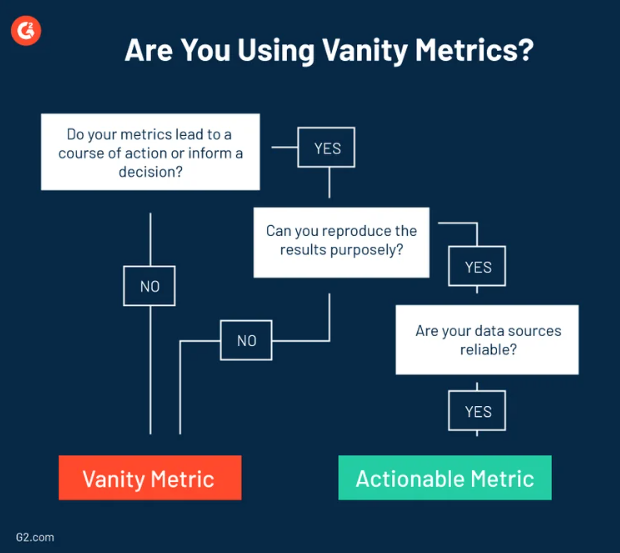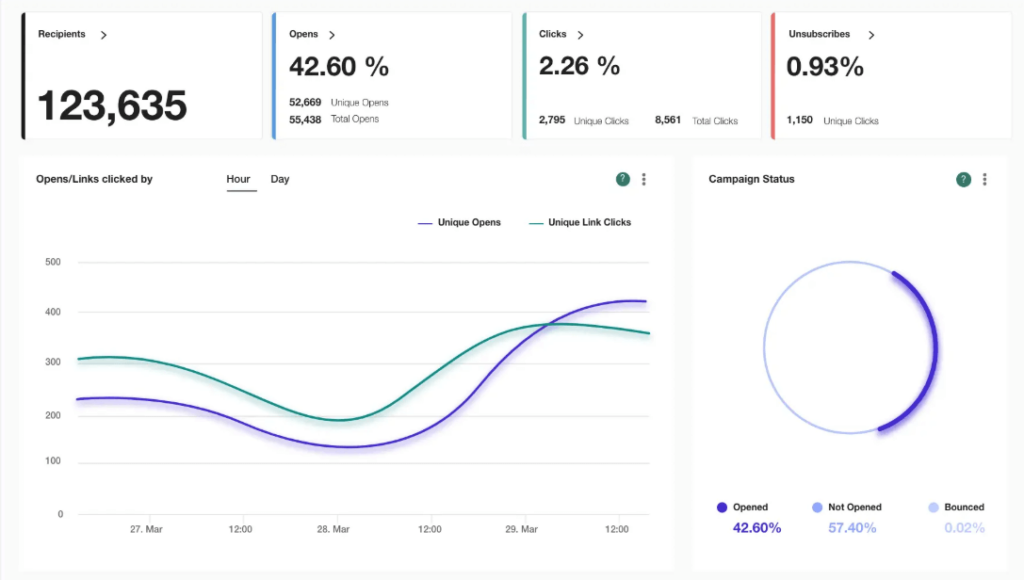
How to Be a More Productive Marketer: Tips and Metrics for Success
You wrap up your day sitting at your desk, reflecting: “Now that’s what we call a productive day.” Meetings flew by, pending tasks were checked off your to-do list, and chats with colleagues left you inspired.
But in the business world, productivity means more than a feeling. It’s a profitability measure, grounded in data.
In this guide, we’ll unpack a concept most marketers have strived to master: marketing productivity. Learn its definition, common metrics, and best practices to not only optimize, but turn it into a driver of business growth.
What Is Marketing Productivity?
Marketing productivity describes how effective and efficient a team or person’s marketing efforts are. It shows how the marketing output, such as promotional or brand awareness campaigns, relates to the input—effort, resources, talent, and costs.
Measuring it is often challenging, as it requires a wide range of data from different channels.
Both internal and external factors affect productivity. Your marketing strategy, team expertise, budget and resource allocation can make or break it. So can competition in your target market, inflation, or rapid algorithm and consumer trends.
Measuring Marketing Productivity: Key Metrics
Marketing often works hand in hand with sales and customer service departments, which can make it difficult to pinpoint exactly who contributed what when evaluating performance. On top of that, every marketing team is unique, and so is their productivity formula.
But certain productivity metrics are heavily—or even exclusively—affected by marketing:
- Lead generation: It shows how many high-quality leads you’ve attracted over a certain period.
- Website traffic: A metric that indicates how many people visit your website.
- Customer acquisition cost: It shows how much it costs to win a new customer.
- Conversion rates: The percentage of consumers who complete a desired action after visiting your website or other marketing assets, such as email campaigns.
- Content engagement: It shows how people interact with your content and the impact it has.
- Marketing ROI: It indicates the return on investment made directly from marketing initiatives.
- Marketing pipeline contribution: This metric shows the percentage of sales driven or influenced by marketing.
While some metrics such as social media likes, email open rates, or number of published blog posts can be linked with productivity, they show that part of your strategy was efficient, but not necessarily productive.
Even though customer retention and customer lifetime value are key productivity measures, they’re usually affected by other departments, such as sales and customer service. With clear attribution tactics, you can figure out how marketing efforts contributed to their success.
Moreover, small businesses, especially physical stores, don’t usually depend on growth and digital marketing tactics—at least exclusively. They check how many people step into their stores, how many come back for repeat purchases, or what channels, local or online, bring more customers.
Best Productivity Tips for Marketers
Let’s imagine that you’re a marketing leader or a business owner responsible for growing marketing productivity. Here are some best practices to follow:
1. Set clear marketing goals
As a rule of thumb, setting clear goals is essential for a successful and productive marketing strategy. Before marking them, take time to understand your available resources to make informed, strategic decisions.
Ask yourself key questions during the planning process:
- Is your marketing budget enough for the marketing campaigns you want to run?
- Does your team have enough knowledge to execute your marketing plan?
- Are there any automation tools to streamline certain business processes?
When you’re ready, meet with your team and discuss your goals collaboratively. Your productivity gains will rely heavily on their input, so take their feedback seriously. They may need time for market research or quick training before implementing your plan.
Also, consider how much time each project will require alongside other tasks. Productivity depends on human resources. Overworking your team can lead to burnout and negative outcomes.
2. Choose the right productivity metrics
You can’t turn every productivity metric into a KPI. Doing so would turn your strategy into a complete nightmare. Instead, tie metrics to outcomes you’d like to see soon. For instance, measure content quality by checking average session duration and SEO performance by rankings and backlinks.

In this step, it’s important to tell actionable from vanity metrics. You can use actionable metrics to decide if your business model really works. Vanity metrics, on the other hand, may look impressive but offer little practical value. Think of social media likes; while they show that the content resonated with the viewer, they rarely lead to conversion.
Beyond output, evaluate your input before labeling your work as productive. A viral campaign that brings your target ROI isn’t productive if it drains excessive resources, pulls time away from other valuable tasks, or results in overwhelming manual work.
And remember, quality usually beats quantity. For example, creating a few targeted bottom-of the funnel articles can lead to better results than producing high-volume content that will get lost in the noise.
3. Power up your tech stack
Marketing automation software helps marketers reduce manual work through prebuilt workflows, delivering a seamless customer experience—while making your job easier and more efficient.
From all-in-one tools like HubSpot that support various marketing activities to more dedication solutions, you can choose from a plethora of tools based on your goals. For example, email marketing platforms like Moosend or Constant Contact offer premade tools and automation workflows to save time without compromising quality. They also help track email marketing metrics so you can see where your marketing productivity stands.

Project management software like Asana or Monday has also conquered the marketing world. They help marketers manage campaigns, sync with teammates, reduce manual work, and stay on top of deadlines. They also let business leaders allocate marketing activities wisely and monitor progress without micromanaging.
Finally, analytics and CRM tools like Tableau and Salesforce, allow you to dive deeper into key metrics to unveil customer behavior without wasting valuable time on spreadsheets and paperwork.
4. Sharpen your marketing expertise
Marketing techniques and consumer habits evolve rapidly. No matter how well-trained marketers are, they must keep up with trends. AI showed how quickly modern technology can disrupt the market and affect how we think and operate.
To remain productive, you need to stay ahead of the curve. Embrace the mindset of lifelong learning, through training or research. Block out a two-hour slot every month to take a course or reading marketing newsletters.
If you’re a marketing leader, emphasize the importance of staying up-to-date with marketing trends for your team. Encourage them to develop a diverse skillset based on their interests, so your department can cover a broader range of marketing functions.
What types of skills would elevate marketing productivity? While technical skills like data analysis, SEO, and automation are crucial, soft skills are equally important. Marketers should step into prospects’ shoes regularly to understand their motives and pain points. Empathy, communication, adaptability, and creative thinking are essential for crafting campaigns that truly resonate.
5. Allocate your resources wisely
To boost marketing productivity, knowing how to allocate valuable resources such as time, knowledge, and budget is paramount. Before making big marketing investments, spot what marketing channels perform best. Use data from past campaigns to understand how your audience behaves to focus on tactics that can bear fruit.
Nevertheless, it’s always valuable to experiment with new tactics to keep your strategy fresh and forward-thinking. Keep part of your budget to try out new techniques and tools. This can help you uncover innovative ideas and gain deeper insights into your niche.
Automating repetitive tasks will let your team focus on more creative and strategic projects. Email sequences, social media scheduling, lead nurturing—keeping up with these tasks on spreadsheets can be exhausting. Marketing automation tools eliminate these barriers, ensuring consistency, saving time, and reducing employee burnout.
Review twice per year if your resource allocation works, or conduct an urgent re-evaluation if productivity starts to suddenly drop. To stay truly productive, you must master agility—the ability to adapt quickly, reallocate resources, and pivot strategies when needed.
6. Create a unified marketing dashboard
Keeping marketing data siloed across different channels will turn out to be counterproductive. Moving from one platform to another can result in fragmented results. Instead, a centralized view of your marketing performance can lead to smarter, data-driven decisions.
Monitor real-time insights from all marketing channels to understand how each one performs and intervene if needed. For instance, if you notice a drop in social media performance after a new feature announcement, you can experiment with a new post format, such as an infographic. Alternatively, reallocate budget to a platform that consistently delivers sustainable results.
Finally, share this dashboard with the entire team to ensure they’re aligned. Transparency fosters better collaboration, and you never know who might come up with the next big idea. Encourage a culture of continuous improvement through data and invite your colleagues to contribute new insights and ideas.
Build Your Own Marketing Productivity Formula
Not every productive team and professional looks the same—especially in marketing. The key is to find the best formula for your business and build a productivity-driven strategy that’s backed up by data.
Ensure that everyone is aligned with your productivity goals by setting clear expectations. Ask yourself and your team: What could help us boost productivity without wasting time, energy, or other valuable resources? This mindset will help you stay focused on what truly matters.




 Published by
Published by

 Published by
Published by
